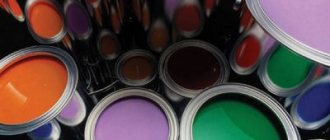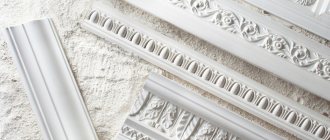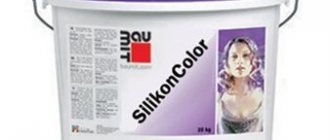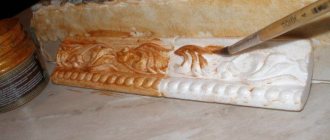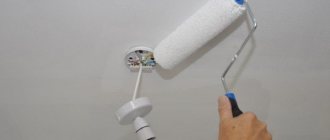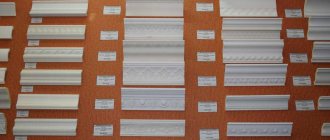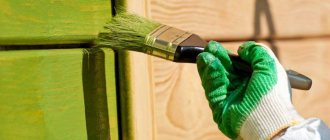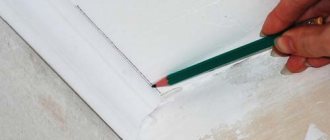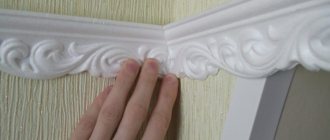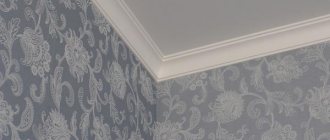When repairing the ceiling in a room, the final stage is how and how to paint the foam plastic ceiling plinth. You can paint skirting boards both before attaching them to the ceiling and after installation. Before painting the baguettes, remember that they are first puttied, eliminating gaps at the joints. The putty also serves as a reliable base for paint.
It is strictly not recommended to paint skirting boards with paints and varnishes based on synthetic solvents - acetone, white spirit, drying oil, etc. These substances are aggressive towards the foam and literally dissolve it in themselves. Then how to paint the foam ceiling plinth? To paint foam fillets, you should use only acrylic or water-based compounds.
Why do you need to paint foam baseboards?
Although the painting technology involves painting both on site and before gluing the planks, professional builders recommend applying paint and varnish to already installed moldings, but there should be no wallpaper on the walls - they need to be glued to the walls when the cornice is painted and dried. It is also advisable to paint the ceiling after painting the fillets. Why is this and not otherwise?
- The finishing decorative layer (wallpaper, paint, panels or tiles) will not get dirty when painting the cornices. If the ceiling is painted in the same shade as the baseboards, then it will be more convenient to implement this at the same time;
- When gluing fragile and brittle PP baguettes, they can easily be deformed or broken, stained with glue or paint, or accidentally scratched. In addition, the joints on a straight section are very noticeable, and they must first be puttied or filled with silicone sealant, and only then a coat of paint must be applied. But all this is done on a glued cornice;
- Wallpaper is glued to the walls after installing the baseboards for the same reason - so as not to stain or damage them. Wallpaper pasted after painting the planks is easier to remove during future repairs - the baseboard will not need to be dismantled and repainted. If the skirting boards are glued to the wallpaper, then with a high degree of probability they will come off when removing the wallpaper, if this needs to be done;
- Since foam plastic absorbs moisture well, condensation penetrates into the porous structure of the material, and the appearance of mold becomes a delayed reality. Therefore, applying paint is a necessary measure not only in terms of design, but also in terms of ensuring the health of residents;
- Even if the design of the molding matches the appearance of the walls and ceiling, it is better to paint the baseboard in a similar color so that it becomes shiny or matte - it depends on the paint chosen. This design technique will make the design solution original and harmonious.
Recommendations for painting PP skirting boards
When installing skirting boards of the same color as the ceiling or walls, the question arises: is it necessary to paint the ceiling plinth if it matches the finish of other surfaces? The technology for manufacturing polystyrene foam is such that it turns out white, and so do the plinths for the ceiling. Therefore, on a white background, all cracks, dents and joints will be very noticeable, and they must be puttied. Putty or silicone will begin to differ in color from foam over time, so they should be painted over.
A few more factors that answer the question of whether it is necessary to paint the foam plastic ceiling plinth:
- An unpainted cornice has an unaesthetic appearance, especially if the products are from a line of cheap decor. The painted surface will be more presentable; you can even achieve an aristocratic look if you imitate the texture of wood, marble, stone or stucco. Visually, such planks are almost impossible to distinguish from natural materials if a master paints them. There is no need to even talk about savings - it is obvious;
- Due to the looseness and fragility of the material, baseboards can be scratched, have dents and breaks, so puttying and painting are inevitable. Therefore, before you buy a foam ceiling plinth, inspect all pieces for damage;
- Even one layer of acrylic or water-based paint will make the surface of the baguette stronger - the plank will be more difficult to scratch, since the dried paint forms a fairly hard coating;
- No matter how beautiful unpainted PP cornices may be, after some time they will turn yellow, become dusty and dirty, and if the baguettes are attached in the kitchen, then covered with soot. It is completely impossible to clean such a surface, even with the most modern detergents: due to its friability, polystyrene foam perfectly absorbs any foreign matter. And the painted surface can be easily cleaned with a regular damp sponge or cloth.
How to paint ceiling tiles
Updating a laminated ceiling by painting is not a difficult task even for a non-professional, but not every paint comes into contact with polystyrene foam without damaging the latter. Many compositions tend to dissolve polystyrene foam, so painting it with enamels containing acetone, white spirit, toluene, etc. is contraindicated. Experts do not recommend covering tiles with oil paint.
Repairs that are safe for foam panels can be made using 3 types of paints and varnishes. They are varieties of water-dispersed coatings and differ only in fillers. Usually painted with the following compositions:
- acrylic paint or varnish;
- water-based;
- latex paint and varnish material.
The compositions do not contain aggressive solvents and have good hiding power, although they have different prices. Restoring tiles with them is possible in a children's room, since the materials do not pose a threat to the child's health.
There is an affirmative answer to the question of whether it is possible to paint foam ceiling tiles, especially since manufacturers produce not only laminated colored panels, but also material specifically designed for subsequent painting.
In kitchens and bathrooms, the appearance deteriorates faster, because it is used in conditions of high humidity, so painting the ceiling tiles in these rooms provides additional protection to the finish and the ceiling itself.
Acrylic paint
It is made on the basis of polyacrylates and their copolymers, but it is odorless and harmless to health. The only drawback of this paint and varnish material is the high price, but this is offset by the following performance characteristics of the acrylic coating:
- resistance to changes in temperature and humidity;
- resistance to fading;
- color saturation.
Acrylic paint for ceiling tiles creates a durable glossy film on it. These compounds are easy to apply and dry quickly. Surfaces painted with them can be washed.
Water-based
You can update foam tiles with water-based paint. A composition based on a water dispersion of pigments and polymers creates a matte surface on the ceiling. Water-based paint is cheaper than other materials intended for painting tiles. To apply it, you can use sprayers, rollers and brushes. It lies evenly on the ceiling, well masking the seams between the panels. The coating has good vapor permeability.
Water-based paint is more prone to peeling and cracking. The coating does not withstand washing well. When finishing surfaces, especially in rooms with high humidity, it is better not to use white paint, as after a short time the ceiling will acquire a dirty gray tint.
Latex
Styrene-butadiene-based paint can create a matte or glossy surface. The moisture-resistant coating is elastic and resistant to ultraviolet rays. It is easy to apply and dries quickly. The disadvantage of paint is that it is not resistant to fungus formation. Paint applied too thickly will peel off.
Tips for choosing
Before painting foam tiles, it is better to find out what composition is suitable for painting indoor surfaces. The choice of a suitable means for updating the ceiling should depend not only on the design preferences of the apartment owner. What paint to paint tiles in the kitchen, bathroom or bedroom must be decided based on the characteristics of the paint coating.
When finishing surfaces, especially in rooms with high humidity, it is better not to use water-based and latex paints. In the kitchen and bathroom, it is advisable to use a more moisture-resistant acrylic-based composition. This material is better cleaned from contaminants.
If you still choose water-based paint, then the tiles in the bathroom and kitchen should not be painted white, as after a short time the ceiling will acquire a dirty gray tint. When choosing a composition for painting tiles, you need to remember that the applied coating may lighten or darken after drying.
Staining technique
Usually, self-taught craftsmen do not know how to evenly paint skirting boards, and do it on a whim. Meanwhile, white acrylic coatings are sold, which can be painted with special colors that have all the colors of the palette. You can mix several colors to achieve the desired shade. The color paste is added to the paint and mixed thoroughly. Also, construction supermarkets have long installed special tinting machines that will help you choose the required shade.
If you plan to paint glued fillets, you can use both paint in cans and paint in spray bottles. But spraying is recommended to be used only if the walls and ceiling have not yet been completely finished. The only drawback of canned paint is that it is impossible to change its color. Therefore, when purchasing ceiling plinth wholesale in Moscow, you need to immediately take care of purchasing the required amount of paint of the chosen color.
After choosing the main color for the ceiling moldings, the surfaces need to be prepared:
- Fill with fine-grained finishing putty. To do this, use a rubber spatula with a blade width of 2-4 cm;
- Instead of putty, you can work with colorless or white silicone-based sealant;
- Water-based paints adhere unevenly to the surface of plastic. You need to prime them first.
- Polystyrene foam is difficult to paint, so first the surface of the cornice must be primed. Primers are made on an acrylic or latex base in the form of solutions of aqueous emulsions. The primer layer clogs the pores and crevices, reducing the consumption of paintwork materials, which will lie smoothly and evenly on the primer. Protective substances are applied with light pressure with a spatula or brush - from top to bottom, so that both primers and mastics fill the cracks and dents. When working with your fingers, wear rubber gloves, as the substances can be aggressive. Excess sealant or putty is removed with a damp sponge or cloth;
- In the same way, corner joints and gaps between the wall, ceiling and molding are covered. The dried putty is sanded with No. 0 sanding paper. Next, the ceiling plinth for suspended ceilings is cleaned of dust and coated with a primer.
There are several options when it is better to paint polystyrene foam molding:
- Before gluing. The disadvantage of painting fillets that have not yet been installed is that you can make mistakes when cutting moldings to size, and this will force you to make new expenses and buy additional skirting boards;
- After installation, but before the walls are wallpapered or painted;
- After finishing the decorative finishing of the ceiling and walls of the room. The disadvantage of painting fixed baseboards is that working at height on a stepladder is not only inconvenient, but also dangerous. In addition to these inconveniences, all surfaces will have to be protected with tape or masking tape.
There are no strict instructions on this matter - do what is most convenient for you. But the optimal solution would be to choose point No. 2.
Advice:
To give the surface of the cornice a patina effect, use a glaze of the “Taire” color. It is applied to the baguette in an even thin layer. The middle part of the surface is not painted, but the joints of the painted and unpainted surfaces of the molding are shaded with a sponge or cloth, and the top layer of glaze is removed. This simple design technique makes the relief brighter and lighter, deeper relief patterns - richer and more contrasting. Next, use “Umber” glaze to shade the remaining relief, and use a brush to enhance the main color of the baguette.
Painting or installation, which is done first?
Despite the fact that installing skirting boards under the ceilings is the last stage of finishing work, there is no need to rush into installation. We have already figured out that polystyrene foam cornices need painting. But when to do this, when to paint the ceiling plinth, before applying the sticker. This issue deserves separate discussion.
The first option is to paint first, and then install the skirting boards
It is immediately important to note that it is better to do painting in advance, before installing the skirting boards at the joints. The main motive for this technical solution is to keep the finished walls clean, without staining the brand new panels with paint. The painted cornices are then easily mounted with glue in the prepared places without any special difficulties.
This method has its advantages, but in terms of finishing quality it is inferior to another method when painting an already laid baseboard
The painted cornices are then easily installed with glue in the prepared places without any special difficulties. This method has its advantages, but in terms of finishing quality it is inferior to another method when painting an already laid baseboard.
Before painting the cut pieces, the surface of the skirting boards should be degreased and cleaned of dust. According to experts, foam plastic products do not need to be primed; the paint adheres well to the surface of the material. How to paint cut elements? Typically, water-based or acrylic paint is used for these purposes. Latex-based paints and varnishes give the cornices a special shine and rich appearance. Watch the material consumption; you will still need paint for the ceiling skirting boards when painting the joints.
After you have allowed the treated parts of the future structure to dry, you should not rack your brains about how and with what to glue the already painted foam plastic ceiling plinths into place. The adhesive composition should be uniform, not thick and not too liquid. You can buy such a product in a retail chain or prepare it yourself using finishing gypsum putty. Add PVA glue to the composition in a ratio of 1 to 100, and you will get an excellent homemade glue. The glue is applied to both sides of the baguette in small strokes at intervals of 15-20 cm from each other. Protruding glue residues can be easily removed with a brush dipped in water.
After the glue has dried, you can begin sealing the seams and joints on the installed cornice.
The second option is to first install the cornices, then paint
Another technique, which is used to install foam skirting boards on ceilings, is based on the reverse action. First, the cut fragments are mounted on the prepared places, and the seams and joints between the individual fragments are sealed. Only after the glue and putty have dried can you begin to paint the ceiling moldings. How to glue unpainted foam plastic to ceilings and walls? The answer is simple. Use the same technology as in the first case. Apply glue to individual fragments of the plinth in different places, at a distance of 15 cm. Press at the joint and let the glue set.
Do not forget that this technology for installing baguettes is carried out only when your ceiling part and fillets are in the same color scheme, and the wallpaper is still in rolls. How to properly paint a foam plastic ceiling plinth when everything around you already breathes the end of the renovation. Maintain neatness and cleanliness. Painting tape glued to the baseboards will keep the edges of the ceiling and wallpaper from getting paint.
When is it recommended to paint baseboards?
Why is it better to carry out painting of baguettes after gluing them, but before finishing the decorative work on the walls and ceiling? The answer is simple - in addition to the points listed above, there are several more advantages:
- You can experiment with the shades and texture of layers of paint, and there can be several layers;
- The rigidly fixed surface of the cornice is difficult to damage by applying force to a fracture, and it is also impossible to make a dent with a brush;
- If you paint the planks on the floor before attaching them, then after gluing the baseboards you will still have to seal and mask the joints and cracks with paint, and it will be almost impossible to choose the same tone of paint;
- When sealing the cracks between already painted baguettes with sanding paper, the edges of the baseboards will be scratched, and they will also have to be painted over with paint, the tone of which will be different from the original one.
Important: Wallpaper is pasted after installing the moldings, not only for fear of getting them dirty. This must be done so that problems do not arise during operation and future repairs: the wallpaper canvas can warp at high humidity in the room, and the baseboard will move away from the wall, and if you remove the old wallpaper, it can pull the entire strip along with it.
Why paint the baseboards at all, if you can fit all the joints with such precision that they will hardly be noticeable? You don’t have to paint, but in this case very high demands must be placed on the room:
The presence of forced ventilation that works constantly - otherwise dust and soot will stain the baseboards over time and change their color;
There are no ideal surfaces: on every molding you buy you will definitely find dents, unevenness at the ends, and a pattern relief distorted by stamping. This means that when lit at a certain angle, all defects will be very noticeable if they are not puttied and painted over.
Choosing paint and tools
Professional painters recommend purchasing polyvinyl acetate, acrylic or latex water-based paints. If the paint of the desired color is not on sale, buy white and paint it with color.
The tool for painting foam baguettes must be prepared in advance. This:
- Paint brushes of different sizes and hardness;
- Paint roller if the cornices are flat and wide;
- Rubber spatula with a blade width of 2-4 cm;
- A paint tray in which the brush or roller will be dipped;
- Dry cloth and sponge;
- Paint and color set.
The most common design technique that does not require a lot of money and effort is to paint the ceiling and baseboards in the room in the same color scheme at the same time. As a precautionary measure for such painting, it is recommended to protect the floor with polyethylene or other materials. The walls need to be painted or wallpapered after painting the ceiling and moldings.
It is best to paint embossed and patterned cornices with a thin brush - the narrow blade of the brush will allow you to accurately and evenly paint any pattern without staining adjacent surfaces. If the ceiling molding is wide and flat, then it is recommended to work with a wide brush. Also, when painting planks glued to the ceiling, you need to use a wide metal spatula: place it with a blade under the cornice so that the paint does not flow and drip onto the floor and walls. For example, in the right hand there is a brush, in the left - a spatula, onto which the dripping paint will fall. If you don't have a spatula, use a sheet of cardboard or plastic.
If you paint the ceiling and baseboards in the same tone, then paint the surface of the ceiling with a roller and with a baguette with a brush. You need to apply two or three layers; the previous one must dry before applying subsequent layers.
If the ceiling and moldings are of different shades, then the ceiling must be painted first. When applying paint, masking adhesive tape (adhesive tape) is used to protect adjacent adjacent surfaces.
Materials for the production of products
Fillets made of any materials can be of completely different textures and sizes.
Expanded polystyrene
Expanded polystyrene product
Practical, reliable and durable polystyrene foam skirting boards are easy to install and painted in the desired color. However, they should be handled with care, as they are easily deformed.
Not so long ago, duropolymer products appeared on the market and are actively promoted under various brands.
Made from duropolymer
However, in essence, this material is high-density extruded polystyrene.
Polyurethane
Polyurethane
Polyurethane fillets are flexible, and therefore can be easily mounted on surfaces of any shape.
Styrofoam
From foam plastic
Polystyrene foam is an affordable, light-weight and easy-to-install material. The installation of elements made of foam plastic can be easily handled by one person. However, due to its fragility, lack of elasticity, and sensitivity to moisture, there are restrictions for use in the design of curved structures and bathrooms.
It is also possible for cracks to appear in foam fillets installed in new houses if the structure shrinks. Without painting, such skirting boards quickly lose their attractiveness, since the rough surface attracts dirt well.
Gypsum
Gypsum fillets
Such decorative elements are installed to give the interior aristocracy and sophistication. They may suit the court in premises in the Baroque or, for example, classicism style.
In an ordinary standard apartment, gypsum skirting boards will not look entirely appropriate, but in a country cottage they can be used to emphasize the good taste of the owner. Gypsum is a fire-resistant, environmentally friendly material, quite heavy and fragile. Fillets made from it are more expensive than their synthetic counterparts.
Tree
Wooden crafts
A classic version of fillets, especially popular when installed in rooms decorated with wood or materials imitating it. Durable, beautiful and environmentally friendly material.
Skirting boards made of wood must be treated with fire-retardant compounds and antiseptics, since this material is susceptible to external factors (temperature, humidity).
PVC
PVC
These fillets are convenient because, in addition to performing decorative functions, they can be used as a profile for attaching wall or ceiling panels. PVC skirting boards can be painted upon request. It is not easy to paint a smooth surface evenly. Aerosol paints are best suited for these purposes.
Whether dumbbells need coloring or not is not an idle question. After all, at first glance, it seems that they represent an architectural element absolutely ready for use. Let's figure out why painting is done.
How to paint baseboards correctly
The painting technique depends on how cleanly the surfaces – the ceiling and walls of the room – are finished and prepared. If finishing has not been carried out, then the paint can be applied without unnecessary precautions, without protection with a spatula and tape. You can use both a roller and brushes - the main thing is that the paint layer is even and as thin as possible. This is necessary to prevent drips from excess paint from forming on the baseboards.
If all adjacent surfaces have already been prepared and covered with decorative finishing materials, then protection from paint drops is necessary, even if it can be easily washed off if it gets on the walls or ceiling. When washed off along with the paint, you can erase the coating or paint from the wallpaper.
It’s easy to follow the instructions for painting ceiling moldings:
- You need to stick masking tape or masking tape under and above the baseboards;
- Take a little paint onto a roller or brush and apply it along the cornice, spreading the paintwork in an even thin layer. Do not allow the paint to collect in streaks or drops;
- Check the color of the dried baguettes visually: if your requirements are met, then remove the protective tape. If there are flaws, apply another layer;
- Design projects are different. If, according to the designer’s idea, some protruding or concave parts of the PP plinth should be painted a different color, then this is done with a thin squirrel brush. After applying paint to the brush, you need to squeeze it out - on small areas the paint is applied in very small portions.
Sometimes it happens that when you peel off the masking tape, you can pull both the baseboard and the sprayed decor behind it. Therefore, in small areas it is recommended to use a spatula or a sheet of cardboard instead of tape.
The spatula should be applied tightly to the long end side of the baseboard, and then, during the painting process, slowly move it along the cornice together in an increasing painted area. If it is necessary to protect both the ceiling and walls from paint, you should first paint one surface, for example, the bottom, along the walls. After this, repeat the procedure on the upper surface above the ceiling.
Indoor work
The process of coloring foam products consists of several stages. Before you paint the foam, you need to prepare it. A primer is used for this. An aerosol composition is best suited for this purpose; it is simple and easy to apply to the desired object, the surface dries quickly and can be ready for subsequent work in a short time. This product is ideal for priming the desired element indoors.
Before you start painting parts, you need to prime them with an aerosol composition.
At the very beginning of work, you need to clean the surface with a damp cloth and wait until it is completely dry. When using an aerosol primer, it is recommended to shake the bottle for a few minutes before application and then coat the material with it.
The composition is sprayed quickly, applying a thin layer at a distance of 20 cm from the product. 3-5 layers of primer are enough to get a high-quality coating. After this, the material must dry completely. This takes approximately 30-30 minutes. Various irregularities or drips can be removed with a spatula, lightly touching the surface.
